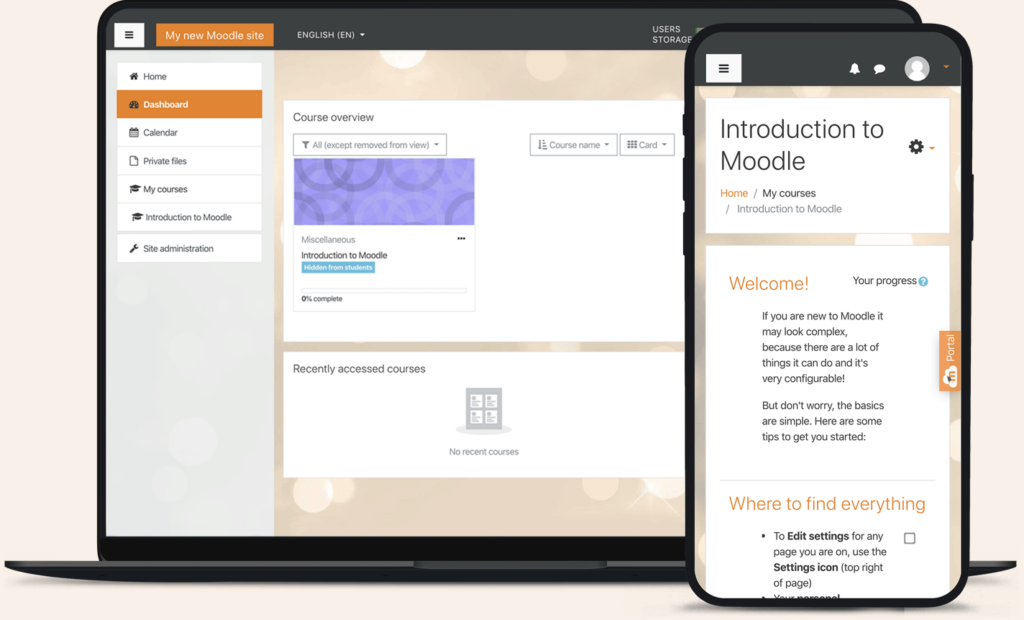Understanding and implementing Moodle’s best practices is essential to unlock its full potential. Moodle is a beacon of empowerment for educators and learners alike in the ever-evolving realm of online education.
As an innovative Learning Management System (LMS), Moodle offers many possibilities to create engaging and effective virtual classrooms.
7 Moodle’s best practices for success
Define your learning objectives
At the heart of every successful course lies clear and measurable learning objectives. Define what your learners want to achieve and the knowledge or skills you want them to acquire.
These objectives will serve as the guiding framework for your course design, ensuring that every element aligns with the desired outcomes.
Organize your course content
Organizing course content coherently and logically is crucial for a seamless learning experience.
Structure your content into sections or topics that are easy to navigate. Utilize headings, subheadings, and bullet points to break up the text, making it more digestible for learners.
Incorporate multimedia elements such as images, videos, and audio into your course content to create an engaging learning environment.
Engaging visuals capture learners’ attention and make complex concepts more accessible. Visual and auditory aids enhance comprehension.
Also, they add variety to the learning experience, making it more stimulating and enjoyable.
Incorporate interactive activities
Promote active learning and keep learners engaged by incorporating interactive activities throughout your course.
Quizzes, discussions, and assignments encourage learners to participate actively and apply their knowledge in practical scenarios.
Design quizzes and assignments that challenge learners to apply their knowledge in real-world scenarios.
The practical application enhances understanding and reinforces learning outcomes.
Provide timely feedback
Feedback is a fundamental aspect of the learning process. Ensure that you offer timely and constructive feedback to learners.
The feedback enables them to track their progress and adjust their approach.
Use Moodle’s tracking and reporting features
Leverage Moodle’s built-in tracking and reporting features to assess learner progress and identify areas to offer additional support.
Data-driven insights empower educators to tailor their teaching approach for optimal results.
Make your course accessible to all learners
Create an inclusive learning environment by considering the needs of all learners, including those with disabilities.
Adhere to accessibility standards to ensure every student can access and benefit from your course content.
Implement group activities that require learners to work together towards a common goal. Collaborative tasks foster teamwork and promote peer learning and problem-solving skills.
Collaborate with colleagues
Learning is a collaborative endeavor. Engage with your colleagues to share best practices, gain valuable feedback, and exchange ideas for course design improvements.
Collaborating with fellow educators fosters a culture of continuous improvement and creativity. Utilize discussion forums to facilitate meaningful discussions and collaboration among learners.
Encourage active participation and create a platform for learners to share their insights and ideas.
Why choose Moodle?
Moodle is an exceptional choice for learning due to its numerous advantages. Its unique features set it apart as a leading Learning Management System (LMS).
Here are some compelling reasons to choose Moodle for your e-learning needs:
- Free and open source- it’s free to download and use, and its source code is open to the public. Anyone can contribute to the development of Moodle, and a large community of Moodle users and developers can provide support.
- Flexible and customizable- can be customized to meet the needs of any organization. Change the look and feel of Moodle, add new features, and integrate with other systems.
- Extensible- has a large library of plugins and add-ons that can be used to extend its functionality. Add new features to Moodle without having to modify the core code.
- Scalable- Moodle is a scalable platform that can support many learner populations. It can be used to deliver courses to small groups of learners or large, global audiences.
- Secure and reliable- it is regularly updated with security patches and has a good track record of uptime.
- User-friendly- Moodle is user-friendly for both learners and instructors. The interface is intuitive and easy to navigate, and plenty of resources are available to help users get started.
- Supports a variety of learning styles- offers a variety of features that can be used to support different learning styles. For example, learners can access course content in various formats, including text, audio, and video.
To finalize Moodle’s best practices;
Embrace these Moodle best practices and achieve learners’ learning goals effectively. Moodle is a top choice for creating effective and impactful online learning experiences.
With a well-designed and inclusive e-learning experience, you can pave the way for success in the virtual classroom.
Moodle stands out as a reliable, versatile, and user-friendly LMS that caters to the diverse needs of educators and learners.






